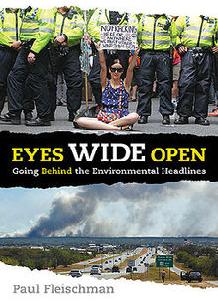Eyes Wide Open (book) facts for kids
 |
|
| Author | Paul Fleischman |
|---|---|
| Country | United States |
| Language | English |
| Subject | Environment |
| Genre | Nonfiction |
| Published | September 23, 2014 |
| Pages | 208 |
| ISBN | 978-0763675455 |
Eyes Wide Open: Going Behind the Environmental Headlines is a nonfiction book for young adults. It was written by Paul Fleischman and came out in September 2014. Candlewick Press published it in the United States. A few months later, in January 2015, Walker Books released it in Australia.
This book helps readers understand big environmental topics. It explores five main areas: population, how much we use, energy, food, and climate. The book uses ideas from history, psychology (how our minds work), and sociology (how groups of people act). It also looks at how money plays a role in these issues.
Eyes Wide Open explains why people react in different ways to environmental problems. It talks about "defense mechanisms." These are ways people might avoid dealing with tough facts. Examples include denialism (pretending something isn't true) or projection (blaming others).
The book also helps you become a better reader and thinker. It has a special section called "How to Weigh Information." This part teaches you how to look closely at what you read. It helps you check where information comes from. The book is full of photos, news headlines, and suggestions for other books, movies, and websites.
Understanding Our Environment
Eyes Wide Open dives into important topics that affect our planet. It helps young readers see beyond simple news headlines. The book encourages you to think deeply about environmental challenges.
What Are the Key Issues?
The book focuses on five major areas. These areas are all connected to how humans interact with the Earth. Understanding them helps us see the bigger picture.
Population Growth and Its Impact
The book discusses how the number of people on Earth affects resources. More people often mean more demand for food, water, and energy. It explores how population changes can influence the environment.
How Much We Use (Consumption)
This section looks at how much stuff we buy and use. It explores how our habits of consuming goods impact the planet. Every product we use requires resources to make and dispose of.
Energy: Powering Our World
Energy is vital for modern life. The book examines different ways we get energy. It also discusses the environmental effects of these energy sources. This includes both fossil fuels and renewable options.
Food: From Farm to Table
Where our food comes from and how it's produced matters. This part of the book explores the environmental footprint of farming. It also looks at how food choices affect the planet.
Climate: Our Changing Planet
The book tackles the complex topic of climate. It explains how human activities can change the Earth's climate. It helps readers understand the science behind these changes.
How Do We React to Environmental News?
Sometimes, big environmental problems can feel overwhelming. Eyes Wide Open talks about common ways people react. These reactions are often called "defense mechanisms."
What is Denialism?
Denialism is when someone refuses to accept a fact or reality. Even when there's strong evidence, they might say it's not true. The book explains why people might do this with environmental issues.
Understanding Projection
Projection is when someone blames others for a problem. Instead of looking at their own part, they point fingers. The book shows how this can happen when discussing environmental challenges.
Regression: Going Backwards
Regression means acting in a less mature way when faced with stress. It's like going back to an older, simpler way of thinking. The book explores how this can affect our response to environmental issues.
Becoming a Critical Thinker
One of the most valuable parts of Eyes Wide Open is its focus on critical thinking. The book wants you to be an active investigator of information.
How to Weigh Information
The book includes a special essay on "How to Weigh Information." This guide helps you read critically. It teaches you to question what you see and hear. You learn to look at the source of information.
Checking Your Sources
The essay encourages you to think about who created the information. Is it a reliable source? Do they have a reason to present things a certain way? This helps you decide if information is trustworthy.
Looking for Evidence
A good critical thinker looks for evidence. Does the information have facts, studies, or expert opinions to back it up? The book helps you spot strong evidence versus weak claims.
Spotting Bias
Everyone has a point of view, or bias. The book helps you recognize if information is presented in a biased way. This allows you to form your own informed opinions.
Images for kids


